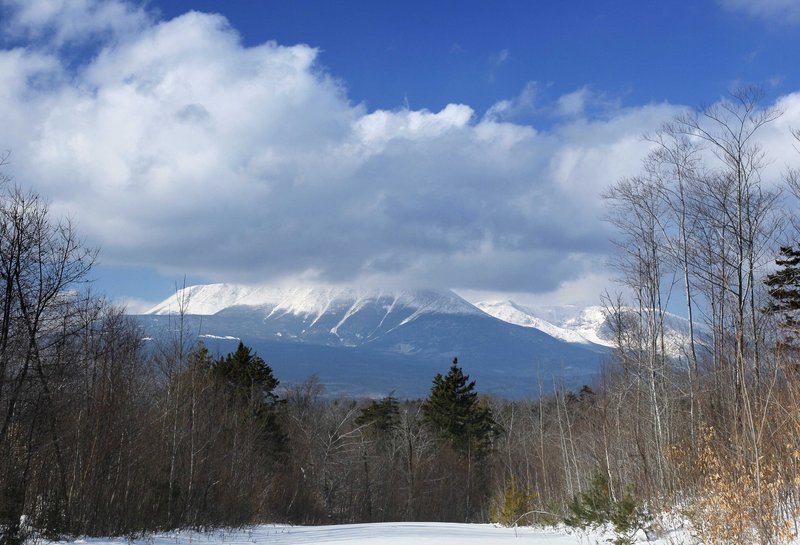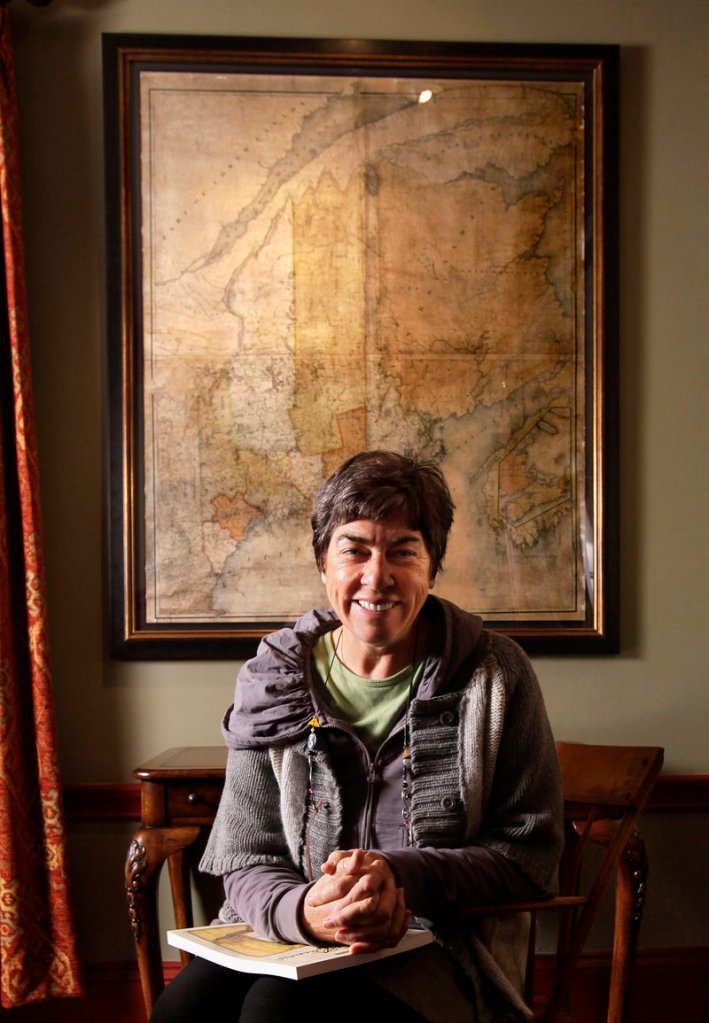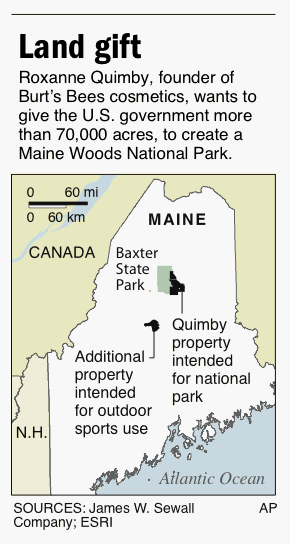TOWNSHIP 3, RANGE 8 — Maine sportsmen were outraged when Roxanne Quimby, the conservation-minded founder of Burt’s Bees cosmetics, bought up tens of thousands of acres of Maine’s fabled North Woods — and had the audacity to forbid hunters, loggers, snowmobiles and all-terrain vehicles on the expanses.
Quimby confronted the hornet’s nest she’d stirred up head-on — calling one of her sharpest critics, George Smith, then-executive director of the Sportsman’s Alliance of Maine. Smith couldn’t believe his ears. The back-to-the-earth advocate who made millions with her eco-friendly line of personal care products was calling him at home, on a Saturday morning?
“I thought someone was playing a joke on me when she called,” Smith recalled. “She said, ‘Hi, this is Roxanne Quimby.’ I said, ‘Oh yeah, sure.’ “
That call in 2006 opened a face-to-face dialogue with some of her biggest critics over the land she’s bought — more than 120,000 acres of woodlands.
Quimby wants to give more than 70,000 wild acres next to Maine’s cherished Baxter State Park to the federal government, hoping to create a Maine Woods National Park. She envisions a visitor center dedicated to Henry David Thoreau, the naturalist who made three trips to Maine in the 1800s.
The park would be nearly twice the size of Maine’s Acadia National Park.
In a giveback to sportsmen, her vision is to set aside another 30,000 acres of woodlands north of Dover-Foxcroft to be managed like a state park, with hunting and snowmobiling allowed. “There’s enough land that we can all get what we want,” Quimby said.
The multimillionaire disarmed her critics, who thought they’d have to deal with a patchouli-scented eccentric. What they found was a woman who thinks big, but is a pragmatic problem-solver; someone who has strong ideals, but is willing to compromise; a self-made businesswoman who’s willing to put up her own millions to achieve her conservation goals.
Smith, for one, came to respect and admire her.
“I was one of her harshest critics, so it’s really rather remarkable,” he said. “In the end, it’s her land and she’ll do whatever suits her. But at least she’s listening.”
If she can win support, Quimby wants to time her donation in five years to the 100th anniversary of the creation of the National Park Service. It would be her gift, her legacy.
The Park Service is intrigued by Quimby’s idea, especially because it believes the Northeast is underserved. The last time a large national park was created was in Alaska in the 1980s during the Carter administration.
“The National Park Service would like to see additional opportunities for preserving these beautiful places and creating recreational opportunities in the Northeast,” spokesman David Barna said. “The proposal would be exciting for the National Park Service to evaluate.”
The proposed national park land occupies a wild sprawl east of Baxter State Park. Much of it is covered with saplings as it recovers from logging that ended five years ago. Mountain ridges offer breathtaking views of Mount Katahdin, Maine’s tallest mountain and the northern end of the Appalachian Trail.
At the eastern boundary is the East Branch of the Penobscot River, on which Thoreau enjoyed a ride in a flat-bottomed bateau on his last visit to the region in 1857.
Animal tracks crisscross the snow-covered land, evidence that it’s teeming with wildlife, even during Maine’s harsh winter. Moose have made figure-8’s in the snow during their playful jousting. Smaller tracks indicate snowshoe hares, fisher cats and coyotes. Endangered Canada lynx also prowl the area.
‘MONEY IN THE BANK’
A native of Massachusetts, Quimby was the black sheep of a family in which her father was an engineer and a salesman, and her sisters both earned their MBAs. Forgoing the business track, she went to art school in San Francisco, where she joined the “good life” back-to-the-land movement led by Helen and Scott Nearing.
With $3,000 in savings, she and her boyfriend ended up in Maine in 1975 — not because of the state’s rugged natural beauty but because the land was cheap.
They bought 30 acres in Guilford and built a cabin with an outhouse. They cut their own firewood. What staples they didn’t grow, they bought in 60-pound bags.
Eventually, Quimby met beekeeper Burt Shavitz, the namesake whose face appears on the labels of Burt’s Bees lip balm, moisturizers and shampoos.
Quimby used Burt’s beeswax to create candles she sold at craft fairs in 1984. In the first year, her company made $20,000. The candles gained popularity in boutiques and specialty stores and within five years, there were 40 employees. In 1991, Burt’s Bees introduced what remains its most popular product — lip balm made from beeswax.
As the business grew, Quimby did something that stabbed at the heart of Mainers: She moved her business out of Maine, which she said was a punishing place to do business.
She relocated to a windowless, climate-controlled building the size of a small Walmart in a North Carolina industrial park. She eventually bought out Shavitz’s shares.
Quimby made plenty of money without an MBA, moving easily between the business world and her passions for art, wildlife, conservation and the environment. As Burt’s Bees grew, she began buying land for conservation in Maine.
“It was like putting money in the bank, as far as I was concerned. I had always had the feeling this land was really priceless. You know, forestland or any kind of undeveloped land. It just seemed like, ‘What a bargain. They’re selling it for $200 an acre? You gotta be kidding me. It’s priceless.’ “
In 2003, she sold 80 percent of Burt’s Bees for $170 million, she said. The investor group told her she’d make that much again, when the remaining 20 percent was sold. And indeed, she made another $180 million when she sold her remaining stake four years later to Clorox, which now owns Burt’s Bees.
That money — roughly $350 million — will buy a lot of land.
SOME SPORTSMEN UNEASY
Quimby, now 60, says she always felt Maine tugging at her and later learned why. It is her spiritual home, where her forebears had settled. The Quimby name runs deep in Maine.
But to many Mainers, she’ll always be “from away” — Maine’s expression for an outsider — because she wasn’t born here. And her vast land purchases continue to make some sportsmen uneasy because she’s personally opposed to hunting and the use of noisy and oil-consuming snowmobiles and ATVs.
Paul Reynolds, an outdoorsman and editor of the Northwoods Sporting Journal, was particularly alarmed late last year when Quimby was named to the National Park Foundation, which raises money to assist park service programs and acquisitions. The post could give her influence with the Park Service.
Reynolds believes that despite her concessions to sportsmen, Quimby shouldn’t be trusted because at her core she’s opposed to hunting and motorized recreation. He’s described her as a “clever tactician” and “a shrewd, self-made businesswoman” who knows how to get her way. “I’m not convinced that she’s had a turn of heart,” he said.
Bob Meyers of the Maine Snowmobile Association sees things differently. He credits Quimby for opening a discussion with sporting groups and other stakeholders and for working to accommodate others’ needs.
“The door kind of swung both ways. We have a pretty good relationship with her now. I think she feels the same way about us. We communicate on a regular basis. That’s the way it should be,” he said.
Things have changed since Quimby first started buying land. The state’s mighty paper mills have continued to struggle, and unemployment remains high. Vast tracts of land are changing hands. Seattle-based Plum Creek Timber Co. plans the largest subdivision in Maine history in the Moosehead Lake region, part of the wilderness where Thoreau tromped.
Plum Creek’s development plan reminded all that large, unspoiled tracts that aren’t conserved could be turned into housing tracts by private landowners.
Quimby says a new national park would conserve land and create jobs by drawing millions of additional visitors to the region to stay and spend.
It remains to be seen whether Quimby is one day mentioned in the same breath as Percival Baxter, who donated the land that became Baxter State Park, or George Dorr, whose efforts helped create Acadia National Park.
These days, she lives most of the year in a home built by the Baxter family in Portland, where one of her philanthropic organizations is creating an “artist-in-residence” program. Others distribute millions of dollars each year in Maine.
“I have a big imagination and I’m an artist and I went to art school, so I’ve fostered that sort of big-picture stuff. But I’m really interested in getting things done,” she said.
Eugene Conlogue, town manager in Millinocket, said many outdoorsmen remain incensed over her restrictions on land they’re accustomed to using for recreation, and for professional logging. But he sees a multi-faceted person.
“You can trust her word. She’s one of these folks that if you shake her hand on a deal, then it’s a deal,” Conlogue said.
Send questions/comments to the editors.





Success. Please wait for the page to reload. If the page does not reload within 5 seconds, please refresh the page.
Enter your email and password to access comments.
Hi, to comment on stories you must . This profile is in addition to your subscription and website login.
Already have a commenting profile? .
Invalid username/password.
Please check your email to confirm and complete your registration.
Only subscribers are eligible to post comments. Please subscribe or login first for digital access. Here’s why.
Use the form below to reset your password. When you've submitted your account email, we will send an email with a reset code.